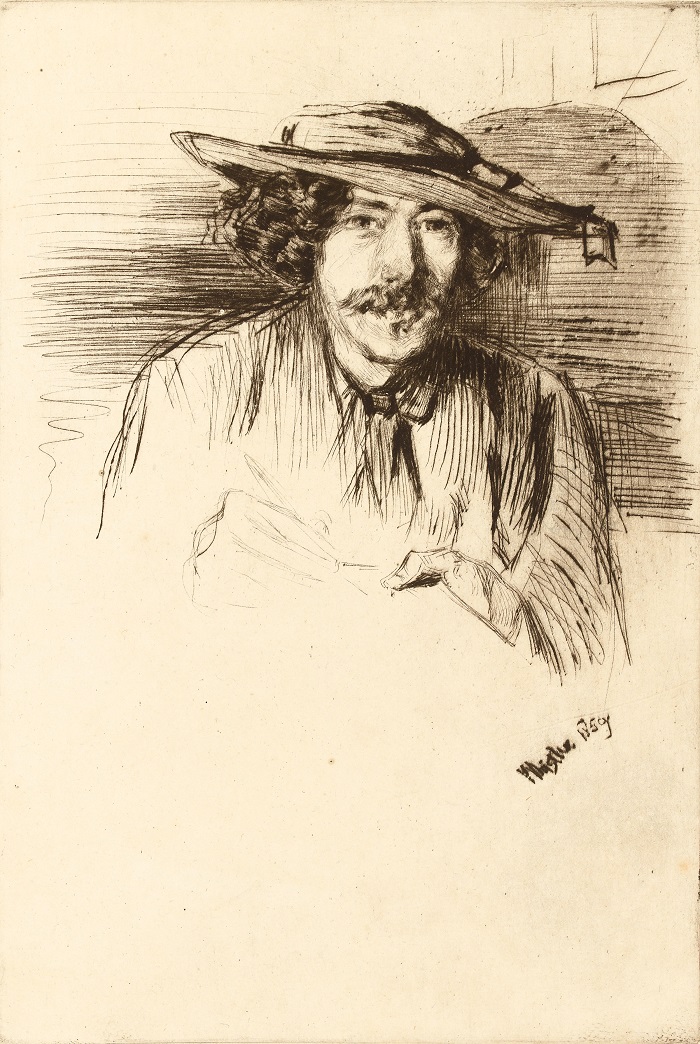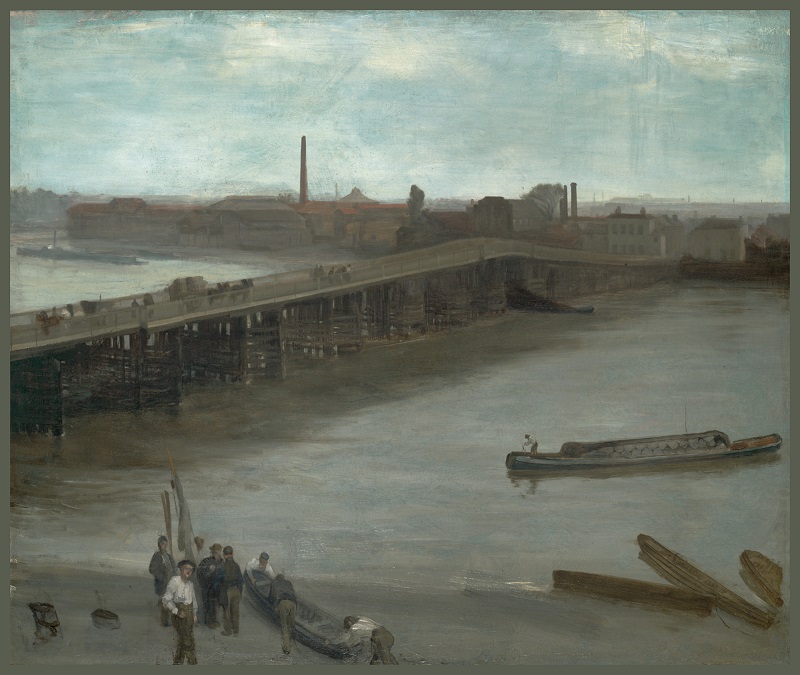Whistler and the Thames: An American in London, Dulwich Picture Gallery | reviews, news & interviews
Whistler and the Thames: An American in London, Dulwich Picture Gallery
Whistler and the Thames: An American in London, Dulwich Picture Gallery
The river views find London's resident American becoming himself

Dulwich Picture Gallery, the oldest publicly accessible painting collection in England, is hardly on the bank of the Thames, but its compilation of prints, drawings, watercolours and paintings by James McNeill Whistler (1834-1902) concentrates on his absorption with London’s river.
Whistler happened to be American, and had a boyhood education in St Petersburg; he left America for good when he was 21, and studied first in the ateliers of Paris. In London for almost all his working life, he lived close to the river at several studios and homes in Chelsea and, not unlike Monet, he too once took up residence at the Savoy overlooking the Thames for several months in 1896 when his beloved wife Beatrix was dying of cancer. The attractive flamboyance of his dandified personality does not obscure the intensely hard work and experimentation that was at the core of his work. This exhibition may be about Whistler and the river but it also shows us Whistler becoming Whistler, moving from the realistic and at times even the literal, to the imaginative and evocative.
 Dulwich’s display allows us to see his technically accomplished prints close up. His curiosity and energy enabled him to amplify his ability to evoke in the studio scenes he committed to visual memory through his acute observation. He vividly trained his visual memory, as he could hardly sketch while being rowed on the river at night. But also he added lithography and lithotint and further collaborating with accomplished printers to his abilities in etching and drypoint. He expanded his visual vocabulary through expanded technical possibilities. (Pictured above right, A Portrait of Whistler, 1859, British Museum)
Dulwich’s display allows us to see his technically accomplished prints close up. His curiosity and energy enabled him to amplify his ability to evoke in the studio scenes he committed to visual memory through his acute observation. He vividly trained his visual memory, as he could hardly sketch while being rowed on the river at night. But also he added lithography and lithotint and further collaborating with accomplished printers to his abilities in etching and drypoint. He expanded his visual vocabulary through expanded technical possibilities. (Pictured above right, A Portrait of Whistler, 1859, British Museum)
The first prints - etchings and drypoints – on view are mostly literal descriptions of complex and artistically well-edited scenes of the working Thames, replete with complex groupings of boats, longshoremen, captains, Rotherhithe, Billingsgate, various bridges, even the Thames police station at Wapping. The detail was praised at the time for being picturesque, and although he edited and realigned his visual observations to make them more compelling and convincing, he persuades us of their reality. What is also striking is the awkwardness of some of the earliest Thames paintings on view with little concession to making the scenes beguiling: things are overcast without that sense of shifting light and changing skies, of the sheer beauty that Whistler was just a little later to find in even the most unpromising and gritty view of the river.
Soon though he was able to truthfully say that what a picture represented depended on who looked at it, to celebrate change and ambiguity, and to become a prime explorer of the possibilities not only of graphic art but of painting.
 By the 1870s he could paint a Nocturne where small boats, piers and a bridge appear as ghostly bodies in crepuscular light, half seen and wholly mysterious, even romantic. Other nocturnes describe a warm summer night by Westminster Bridge, a symphony in grey depicting an early morning on the Thames. By the 1880s he could produce such marvels as the audacious and atmospheric watercolour Blue and Sliver: The Thames, in evanescent pinks, greys, purples, describing the river punctuated by the horizontal of Hungerford Bridge, the whole under an expansive and cloud-filled blue sky, and exploiting both the rough texture of the paper itself and using its unpainted lacunae as further lighting effects; equally audacious is Pink and Silver – Chelsea the Embankment with its pair of relaxed behatted men chatting, leaning against the balustrade, young children sauntering along, the Albert Bridge in the background. Single accents of red and pink, the river a pale blue streak, pull the black and grey composition into a satisfying whole. (Pictured above: Brown and Silver Old Battersea Bridge, Addison Gallery)
By the 1870s he could paint a Nocturne where small boats, piers and a bridge appear as ghostly bodies in crepuscular light, half seen and wholly mysterious, even romantic. Other nocturnes describe a warm summer night by Westminster Bridge, a symphony in grey depicting an early morning on the Thames. By the 1880s he could produce such marvels as the audacious and atmospheric watercolour Blue and Sliver: The Thames, in evanescent pinks, greys, purples, describing the river punctuated by the horizontal of Hungerford Bridge, the whole under an expansive and cloud-filled blue sky, and exploiting both the rough texture of the paper itself and using its unpainted lacunae as further lighting effects; equally audacious is Pink and Silver – Chelsea the Embankment with its pair of relaxed behatted men chatting, leaning against the balustrade, young children sauntering along, the Albert Bridge in the background. Single accents of red and pink, the river a pale blue streak, pull the black and grey composition into a satisfying whole. (Pictured above: Brown and Silver Old Battersea Bridge, Addison Gallery)
Whistler demonstrates increasing sophistication against increasing odds: bankruptcy caused by the failure of his libel suit against John Ruskin who called him a coxcomb, personal sorrow with the death of his wife, quarrels – he tried to throw his brother-in-law through a window – not to mention disputes, financial and other, with patrons. He was affectionate, loyal, maddening, highly intelligent with an acerbic wit, and naturally a friend of Oscar Wilde. His influence not only through his art but his attitudes is still of import, his views about art prescient. This show, perhaps inadvertently, shows him learning his trade, continually experimenting, finding new ways to look. It is unusually illuminating in demonstrating through the fireworks of his public life the tenacity that made him such a fine artist among fine artists.
Explore topics
Share this article
Add comment
The future of Arts Journalism
You can stop theartsdesk.com closing!
We urgently need financing to survive. Our fundraising drive has thus far raised £49,000 but we need to reach £100,000 or we will be forced to close. Please contribute here: https://gofund.me/c3f6033d
And if you can forward this information to anyone who might assist, we’d be grateful.

Subscribe to theartsdesk.com
Thank you for continuing to read our work on theartsdesk.com. For unlimited access to every article in its entirety, including our archive of more than 15,000 pieces, we're asking for £5 per month or £40 per year. We feel it's a very good deal, and hope you do too.
To take a subscription now simply click here.
And if you're looking for that extra gift for a friend or family member, why not treat them to a theartsdesk.com gift subscription?
more Visual arts
 'We are bowled over!' Thank you for your messages of love and support
Much-appreciated words of commendation from readers and the cultural community
'We are bowled over!' Thank you for your messages of love and support
Much-appreciated words of commendation from readers and the cultural community
 Photo Oxford 2025 review - photography all over the town
At last, a UK festival that takes photography seriously
Photo Oxford 2025 review - photography all over the town
At last, a UK festival that takes photography seriously
![SEX MONEY RACE RELIGION [2016] by Gilbert and George. Installation shot of Gilbert & George 21ST CENTURY PICTURES Hayward Gallery](https://theartsdesk.com/sites/default/files/styles/thumbnail/public/mastimages/Gilbert%20%26%20George_%2021ST%20CENTURY%20PICTURES.%20SEX%20MONEY%20RACE%20RELIGION%20%5B2016%5D.%20Photo_%20Mark%20Blower.%20Courtesy%20of%20the%20Gilbert%20%26%20George%20and%20the%20Hayward%20Gallery._0.jpg?itok=7tVsLyR-) Gilbert & George, 21st Century Pictures, Hayward Gallery review - brash, bright and not so beautiful
The couple's coloured photomontages shout louder than ever, causing sensory overload
Gilbert & George, 21st Century Pictures, Hayward Gallery review - brash, bright and not so beautiful
The couple's coloured photomontages shout louder than ever, causing sensory overload
 Lee Miller, Tate Britain review - an extraordinary career that remains an enigma
Fashion photographer, artist or war reporter; will the real Lee Miller please step forward?
Lee Miller, Tate Britain review - an extraordinary career that remains an enigma
Fashion photographer, artist or war reporter; will the real Lee Miller please step forward?
 Kerry James Marshall: The Histories, Royal Academy review - a triumphant celebration of blackness
Room after room of glorious paintings
Kerry James Marshall: The Histories, Royal Academy review - a triumphant celebration of blackness
Room after room of glorious paintings
 Folkestone Triennial 2025 - landscape, seascape, art lovers' escape
Locally rooted festival brings home many but not all global concerns
Folkestone Triennial 2025 - landscape, seascape, art lovers' escape
Locally rooted festival brings home many but not all global concerns
 Sir Brian Clarke (1953-2025) - a personal tribute
Remembering an artist with a gift for the transcendent
Sir Brian Clarke (1953-2025) - a personal tribute
Remembering an artist with a gift for the transcendent
 Emily Kam Kngwarray, Tate Modern review - glimpses of another world
Pictures that are an affirmation of belonging
Emily Kam Kngwarray, Tate Modern review - glimpses of another world
Pictures that are an affirmation of belonging
 Kiefer / Van Gogh, Royal Academy review - a pairing of opposites
Small scale intensity meets large scale melodrama
Kiefer / Van Gogh, Royal Academy review - a pairing of opposites
Small scale intensity meets large scale melodrama
 Jenny Saville: The Anatomy of Painting, National Portrait Gallery review - a protégé losing her way
A brilliant painter in search of a worthwhile subject
Jenny Saville: The Anatomy of Painting, National Portrait Gallery review - a protégé losing her way
A brilliant painter in search of a worthwhile subject
 Abstract Erotic, Courtauld Gallery review - sculpture that is sensuous, funny and subversive
Testing the boundaries of good taste, and winning
Abstract Erotic, Courtauld Gallery review - sculpture that is sensuous, funny and subversive
Testing the boundaries of good taste, and winning
 Edward Burra, Tate Britain review - watercolour made mainstream
Social satire with a nasty bite
Edward Burra, Tate Britain review - watercolour made mainstream
Social satire with a nasty bite

Comments
Whistler and Wilde engaged in